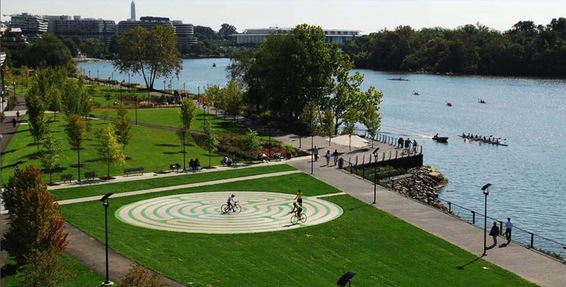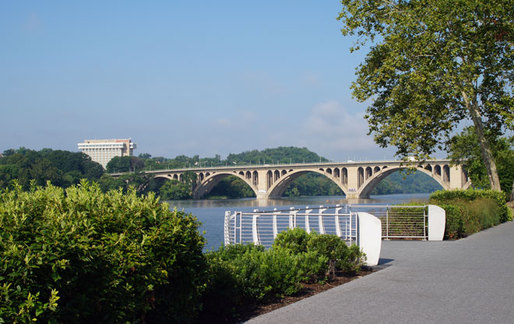Georgetown Waterfront Park - Washington, DC
Washington, DC is a city defined by incredibly accessible, popular, and free public spaces and parks. From the grand National Mall to the various monuments that are interspersed throughout the city, America's capital city is a prime example of the benefits that occur when public space is given a top priority. The city is situated on the shores of the scenic Potomac River, which separates Washington from the state of Virginia. Throughout time, the city, in coordination with the National Park System, has provided nearly uninterrupted access to the shores of the Potomac via a system of paths, trails, and parks. However, the area of the river in the Georgetown neighborhood was until recently not a part of this system. This changed in 2011 when Georgetown Waterfront Park was finally completed and opened to the public.
Until the early 1960s, the waterfront in Georgetown was a busy and successful port that was lined within wharves, warehouses, and ships coming and going. However, the area was condemned in order to make way for a proposed interstate highway. This actions was completely in line with several similar urban renewal initiatives that were seeping across older urban areas at the time along the massive thirst for new roads. In the end, the highway was never built, but the damage had already been done. A local economic engine and a once busy part of the city was now completely abandoned. Shortly this process was complete, citizen efforts began to push and advocate for turning the area into parkland. As is often the case in these types of projects, the pace and progress of the effort was extremely slow. Finally, in 1985, Washington transferred the land to the National Park Service, giving renewed hope to park advocates. By the late 1990s, conceptual designs began to be developed and the park was closer to becoming a reality.
As of September 2011, the park was finally fully completed, almost 50 years after the initial condemnation of the port. The park provides the last link on a 225 miles stretch of parkland along the Potomac that spans from Mt. Vernon, Virginia to Columbia, Maryland. The completed park provides recreation and relaxation amidst the bustle of Washington, DC. It is haven for cyclists and pedestrians as they have separate paths along the river that is completely isolated from automobile traffic. Park users enjoy magnificent views of the rivers, kayakers, boaters, the Key Bridge, The Kennedy Center, as well as Roosevelt Island. Numerous shade tees and gentle hills are also present throughout the park's 10 acres. The completed park is a welcome addition to the nation's capital and fits in perfectly with the city's devotion to providing well-designed public space.
Until the early 1960s, the waterfront in Georgetown was a busy and successful port that was lined within wharves, warehouses, and ships coming and going. However, the area was condemned in order to make way for a proposed interstate highway. This actions was completely in line with several similar urban renewal initiatives that were seeping across older urban areas at the time along the massive thirst for new roads. In the end, the highway was never built, but the damage had already been done. A local economic engine and a once busy part of the city was now completely abandoned. Shortly this process was complete, citizen efforts began to push and advocate for turning the area into parkland. As is often the case in these types of projects, the pace and progress of the effort was extremely slow. Finally, in 1985, Washington transferred the land to the National Park Service, giving renewed hope to park advocates. By the late 1990s, conceptual designs began to be developed and the park was closer to becoming a reality.
As of September 2011, the park was finally fully completed, almost 50 years after the initial condemnation of the port. The park provides the last link on a 225 miles stretch of parkland along the Potomac that spans from Mt. Vernon, Virginia to Columbia, Maryland. The completed park provides recreation and relaxation amidst the bustle of Washington, DC. It is haven for cyclists and pedestrians as they have separate paths along the river that is completely isolated from automobile traffic. Park users enjoy magnificent views of the rivers, kayakers, boaters, the Key Bridge, The Kennedy Center, as well as Roosevelt Island. Numerous shade tees and gentle hills are also present throughout the park's 10 acres. The completed park is a welcome addition to the nation's capital and fits in perfectly with the city's devotion to providing well-designed public space.


